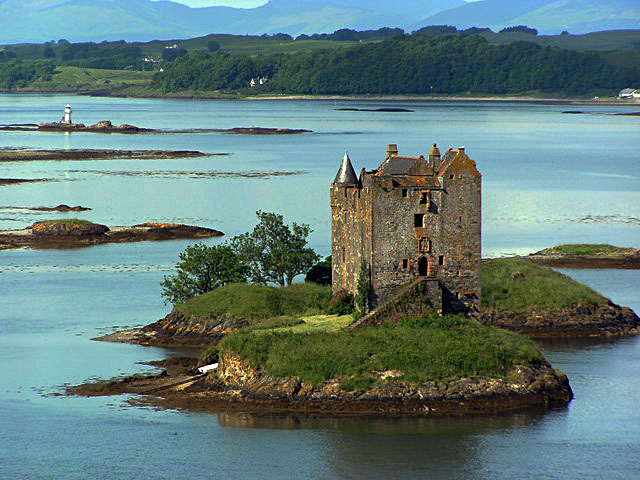Castle Stalker, or Stalcaire in Gaelic, is a stocky stone keep on an island in Loch Laich, part of Loch Linnhe, and is overlooked by the small town of Portnacroish in western Scotland. The island itself is thought to be one of the hundreds of prehistoric crannogs found throughout the lochs of Scotland: small man-made islands set apart from the mainland affording protection and safety from attack.
The first recorded occupation of the island appears to have been by Clan MacDougall, Lords of Lorne, during the twelfth and thirteenth centuries, during their long, hard fought battles to push into the mainland from the west coast of Scotland and its islands. It’s thought that the original fortification would have been built in around 1320. Sir John Stewart is credited with building the current castle in the 1440s, marking a significant chapter in the castle’s history.

Ownership passed between them and the crown during the fourteenth century and the surrounding lands and title eventually came into the hands of the Stewarts in around 1380. By the late 1400s, the castle had been rebuilt by Duncan Stewart of Appin, a cousin of James IV, showcasing the continuous involvement of the Stewart family in the castle’s history and its surrounding lands were used for arable and agricultural farming. It was also useful as a hunting lodge for James IV who was a keen hunter and falconer and made occasional visits to the area.
The position of the keep is such that access to it was very much dependant upon the tide and the weather and gave privacy as well as security to the landowners, even to the extent that the Great Hall was only accessible by way of a ladder which could be hauled up in the event of a surprise attack. Even today, access to the island is very much governed by weather and high water.
A long running feud
A bloody feud, already simmering between the Stewarts and the Campbells, erupted when in 1520 Alexander Stewart was ambushed and killed by the Campbells in a surprise attack just yards from Castle Stalker. The infant son and heir, Donald Stewart, was allegedly hidden in the castle to avoid detection and upon his coming of age swore to avenge his father’s death and murdered several Campbell clan members in reprisal.
The castle appears to have been a valuable prize for the Campbells. In 1620, Duncan Stewart staked everything he had in a bet during a drinking session with one of the Campbells, lost the castle in a drunken wager, and gained a small cargo boat in exchange; Campbell held Stewart to the bet, immediately took possession, and drove the Stewarts out. Campbell’s questionable ownership was short-lived. Upon application by the Stewarts to the Privy Council, the castle passed back to the Stewarts, and it took a long siege to finally evict the Campbells from the castle.
The castle was destined to change hands between the Stewarts and the Campbells many times over the years, and by the time of the famous ‘45 Jacobite Rebellion, the Castle was back in the hands of the Campbells. It was commandeered for use at one point as a government outpost, but the Campbells continued to use it as a residence until about 1800 when they built a new house at Airds a couple of miles away and simply used the Castle as a storage area.
The Stewarts finally regained possession from the Campbells when in 1908 Charles Stewart managed to negotiate its purchase. He made some minor repairs, but it wasn’t until 1965 when Lt Col Stewart Allward bought the Castle from Charles Stewart’s successors that work was undertaken to bring it back to being a working and habitable castle. It now stands rebuilt and refurbished and is in use as a private residence.
The Holy Grail
As a final, lighter note to follow the turbulent history of the castle and the surrounding lands, Python fans will be aware that Castle Stalker has the privilege of having starred in a cameo role in the last scenes of Monty Python and the Holy Grail.
Visiting Castle Stalker in Western Scotland
Visits to see the castle and the setting for these final scenes are by appointment on specific dates but the owners are glad to arrange tours, and for an interesting preview there is a virtual tour on the official website, which takes the visitor right round the castle, , showcasing the panoramic castle stalker view that includes Loch Linnhe, and the Islands of Mull & Lismore.
Additionally, the site features a gift shop offering a variety of Scottish-themed items, from books to jewellery, ensuring a pleasant shopping experience for visitors. The cafe and viewing points boast good disabled access, emphasizing inclusivity for visitors with mobility issues. For those looking for refreshments, the Old Inn near Castle Stalker is highly recommended for its characterful ambiance and open fire. The area’s natural beauty is further highlighted by the tidal marshes of Loch Laich, suggesting it as a point of interest for ecological exploration.
For tickets and tour availability, visit castlestalker.com.
Read more about other Castles in Scotland.